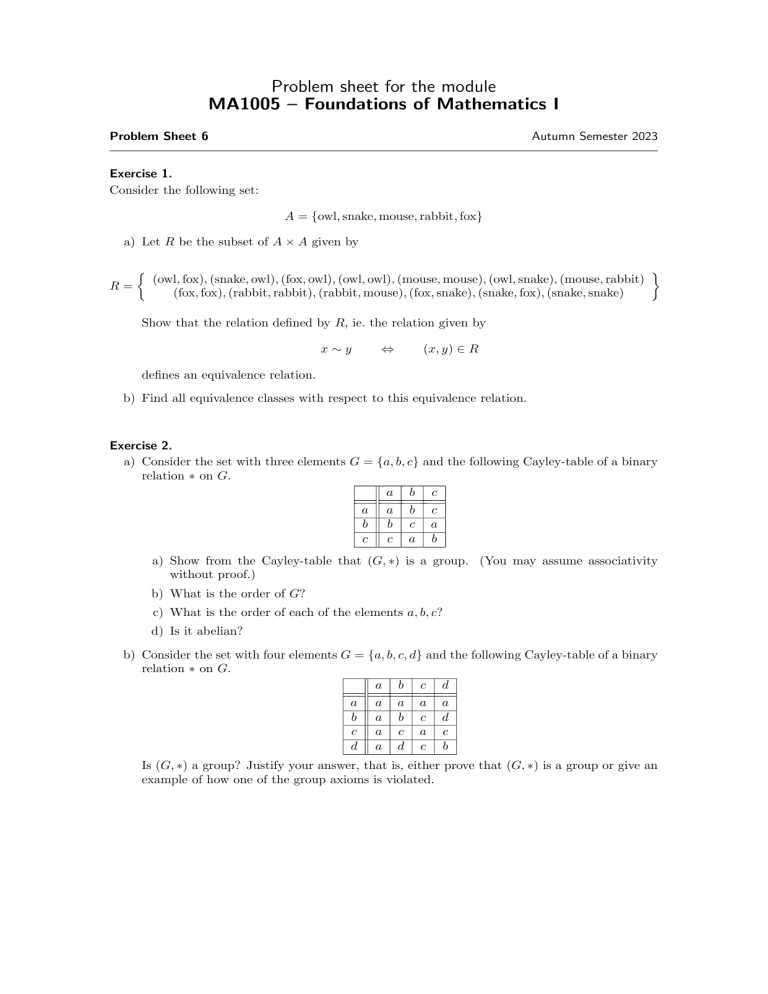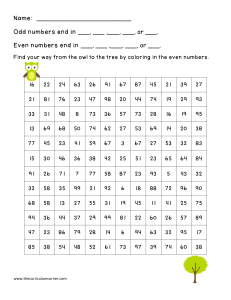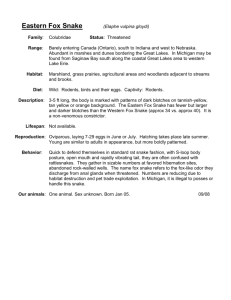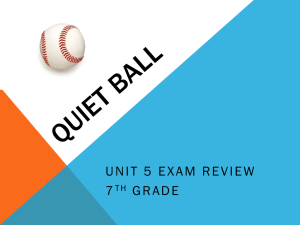
Problem sheet for the module
MA1005 – Foundations of Mathematics I
Problem Sheet 6
Autumn Semester 2023
Exercise 1.
Consider the following set:
A = {owl, snake, mouse, rabbit, fox}
a) Let R be the subset of A × A given by
R=
!
(owl, fox), (snake, owl), (fox, owl), (owl, owl), (mouse, mouse), (owl, snake), (mouse, rabbit)
(fox, fox), (rabbit, rabbit), (rabbit, mouse), (fox, snake), (snake, fox), (snake, snake)
"
Show that the relation defined by R, ie. the relation given by
x∼y
⇔
(x, y) ∈ R
defines an equivalence relation.
b) Find all equivalence classes with respect to this equivalence relation.
Exercise 2.
a) Consider the set with three elements G = {a, b, c}
relation ∗ on G.
a b
a a b
b b c
c c a
and the following Cayley-table of a binary
c
c
a
b
a) Show from the Cayley-table that (G, ∗) is a group. (You may assume associativity
without proof.)
b) What is the order of G?
c) What is the order of each of the elements a, b, c?
d) Is it abelian?
b) Consider the set with four elements G = {a, b, c, d} and the following Cayley-table of a binary
relation ∗ on G.
a b c d
a a a a a
b a b c d
c a c a c
d a d c b
Is (G, ∗) a group? Justify your answer, that is, either prove that (G, ∗) is a group or give an
example of how one of the group axioms is violated.
Exercise 3.
a) Justify each step in the following chain of equalities which proves the second cancellation
law:
Let (G, ∗) be a group with identity element e and let x, y, z ∈ G. If y ∗ x = z ∗ x, then y = z.
1.
2.
3.
4.
5.
6.
7.
y = y ∗ e = y ∗ (x ∗ x−1 ) = (y ∗ x) ∗ x−1 = (z ∗ x) ∗ x−1 = z ∗ (x ∗ x−1 ) = z ∗ e = z.
b) Let (G, ∗) be a group with identity element e and let a, b ∈ G. Show that the inverse of a ∗ b
is given by b−1 ∗ a−1 .
Exercise 4.
Let G, H be groups and f : G → H a group homomorphism. Show that in case f is an isomorphism,
the order of an element g ∈ G and its image f (g) coincide. What can you say about the orders of
g and f (g) if you only know that f is a homomorphism?
Hand-in questions
Please submit before Monday, 13th November in the school office.
Exercise 5.
Consider the relation ∼ on the set X = Z given by
n∼m
⇔
n 2 = m2 .
a) Show that ∼ is an equivalence relation.
b) Describe the equivalence classes.
Exercise 6.
Show that the subset of complex numbers given by
G = {1, i, −1, −i}
together with the multiplication of complex numbers as binary operation is a group. You may
assume that the multiplication of complex numbers is associative to show that the binary operation
on G is associative.
Supplementary questions
Exercise 7.
Let G be a group of order 3. Show that after renaming the elements of G, its Cayley table is the
same as the one of the group in Exercise 2)a). Hint: Make good use of the cancellation law.
Exercise 8.
Let (G, ∗) be a group satisfying that (ab)2 = a2 b2 for all a, b ∈ G. Show that G is abelian.



